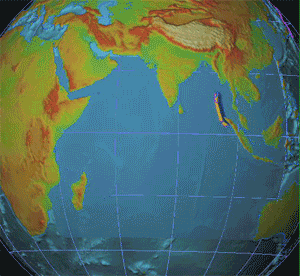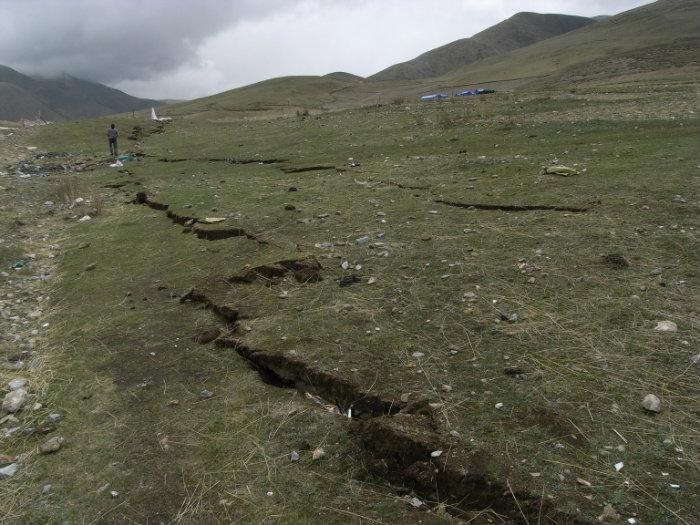|
Supershear Earthquake
In seismology, a supershear earthquake is when the propagation of the Earthquake rupture, rupture along the Fault (geology), fault surface occurs at speeds in excess of the seismic S wave, shear wave (S wave) velocity. This causes an effect analogous to a sonic boom. Rupture propagation velocity During seismic events along a fault surface the displacement initiates at the focus and then propagates outwards. Typically for large earthquakes the focus lies towards one end of the slip surface and much of the propagation is unidirectional (e.g. the 2008 Sichuan earthquake, 2008 Sichuan and 2004 Indian Ocean earthquakes). Theoretical studies have in the past suggested that the upper bound for propagation velocity is that of Rayleigh waves, approximately 0.92 of the shear wave velocity. However, evidence of propagation at velocities between S wave and P wave, compressional wave (P wave) values have been reported for several earthquakesArchuleta,R.J. 1984A faulting model for the 1979 Impe ... [...More Info...] [...Related Items...] OR: [Wikipedia] [Google] [Baidu] |
Seismology
Seismology (; from Ancient Greek σεισμός (''seismós'') meaning "earthquake" and -λογία (''-logía'') meaning "study of") is the scientific study of earthquakes (or generally, quakes) and the generation and propagation of elastic waves through planetary bodies. It also includes studies of the environmental effects of earthquakes such as tsunamis; other seismic sources such as volcanoes, plate tectonics, glaciers, rivers, oceanic microseisms, and the atmosphere; and artificial processes such as explosions. Paleoseismology is a related field that uses geology to infer information regarding past earthquakes. A recording of Earth's motion as a function of time, created by a seismograph is called a seismogram. A seismologist is a scientist who works in basic or applied seismology. History Scholarly interest in earthquakes can be traced back to antiquity. Early speculations on the natural causes of earthquakes were included in the writings of Thales of Miletu ... [...More Info...] [...Related Items...] OR: [Wikipedia] [Google] [Baidu] |
Moment Magnitude Scale
The moment magnitude scale (MMS; denoted explicitly with or Mwg, and generally implied with use of a single M for magnitude) is a measure of an earthquake's magnitude ("size" or strength) based on its seismic moment. was defined in a 1979 paper by Thomas C. Hanks and Hiroo Kanamori. Similar to the local magnitude scale, local magnitude/Richter scale () defined by Charles Francis Richter in 1935, it uses a logarithmic scale; small earthquakes have approximately the same magnitudes on both scales. Despite the difference, news media often use the term "Richter scale" when referring to the moment magnitude scale. Moment magnitude () is considered the authoritative magnitude scale for ranking earthquakes by size. It is more directly related to the energy of an earthquake than other scales, and does not saturatethat is, it does not underestimate magnitudes as other scales do in certain conditions. It has become the standard scale used by seismological authorities like the United State ... [...More Info...] [...Related Items...] OR: [Wikipedia] [Google] [Baidu] |
2013 Craig, Alaska Earthquake
The 2013 Craig, Alaska earthquake (also known as the Queen Charlotte Fault earthquake) struck on January 5, at 12:58 am ( UTC–7) near the city of Craig and Hydaburg, on Prince of Wales Island. The 7.5 earthquake came nearly three months after an 7.8 quake struck Haida Gwaii on October 28, in 2012. The quake prompted a regional tsunami warning to British Columbia and Alaska, but it was later cancelled. Due to the remote location of the quake, there were no reports of casualties or damage. Tectonic setting The Queen Charlotte Fault is a major right-lateral (dextral) strike-slip and transform fault running off the coast of British Columbia and into Southern Alaska, through the Saint Elias Range for more than 700 miles. Its southernmost section joins a spreading ridge of the Gorda plate and the Cascadia subduction zone while the northern termination section joins the a thrust fault where the Yakutat terrane plows into the North American plate. It has been the source of s ... [...More Info...] [...Related Items...] OR: [Wikipedia] [Google] [Baidu] |
Lithosphere
A lithosphere () is the rigid, outermost rocky shell of a terrestrial planet or natural satellite. On Earth, it is composed of the crust and the lithospheric mantle, the topmost portion of the upper mantle that behaves elastically on time scales of up to thousands of years or more. The crust and upper mantle are distinguished on the basis of chemistry and mineralogy. Earth's lithosphere Earth's lithosphere, which constitutes the hard and rigid outer vertical layer of the Earth, includes the crust and the lithospheric mantle (or mantle lithosphere), the uppermost part of the mantle that is not convecting. The layer below the lithosphere is called the asthenosphere, which is the weaker, hotter, and deeper part of the upper mantle that is able to convect. The lithosphere–asthenosphere boundary is defined by a difference in response to stress. The lithosphere remains rigid for very long periods of geologic time in which it deforms elastically and through brittle f ... [...More Info...] [...Related Items...] OR: [Wikipedia] [Google] [Baidu] |
2012 Indian Ocean Earthquakes
The 2012 Indian Ocean earthquakes were Moment magnitude scale, magnitude 8.6 and 8.2 Submarine earthquake, undersea earthquakes that struck near the Indonesian province of Aceh on 11 April at 15:38 local time. Initially, authorities feared that the initial earthquake would cause a tsunami and warnings were issued across the Indian Ocean; however, these warnings were subsequently cancelled. These were unusually large intraplate earthquakes and the largest strike-slip earthquake ever recorded. Tectonic setting The 2012 earthquake's epicenter was located within the Indo-Australian plate, which is divided into two sub- or proto-plates: the Indian, and Australian. At their boundary, the Indian and Australian plates converge at per year in a NNW–SSE direction. This convergence is accommodated by a broad zone of wikt:diffuse, diffuse deformation. As part of that intraplate deformation, north–south trending fracture zones have been reactivated from the Ninety East Ridge as far e ... [...More Info...] [...Related Items...] OR: [Wikipedia] [Google] [Baidu] |
Xianshuihe Fault System
The Xianshuihe fault system or the Yushu-Ganzi-Xianshuihe fault system is a major active sinistral (left-lateral) Fault (geology)#Strike-slip faults, strike-slip fault zone in southwestern China, at the eastern edge of the Tibetan Plateau. It has been responsible for many major earthquakes, and is one of the most seismically active fault zones in China. Tectonic setting The Xianshuihe fault system lies within the complex zone of continental collision between the Indian Plate and the Eurasian Plate. It forms one of a set of sinistral fault zones that help accommodate the eastward spreading of the Tibetan Plateau. The fault zone defines the northern and eastern edges of the Qiangtang block (also known in part as the Sichuan-Yunnan block), and the southeastern boundary of the Bayan Har block. To the southeast it also forms the western margin of the South China Block. Geometry The Xianshuihe fault system comprises several distinct segments, with an overall length of 1,400 km. Th ... [...More Info...] [...Related Items...] OR: [Wikipedia] [Google] [Baidu] |
2010 Yushu Earthquake
The 2010 Yushu earthquake struck on April 14 and registered a magnitude of 6.9 Mw (USGS, EMSC) or 7.1 MsAbout 400 dead, 10,000 injured in 7.1-magnitude quake in China's Qinghai , xinhuanet.com. Retrieved 14 April 2010. ( CEA, CENC). It originated in Yushu, , China, at local time (23:49 April 13 [...More Info...] [...Related Items...] OR: [Wikipedia] [Google] [Baidu] |
Longmenshan Fault
The Longmenshan Fault () is a thrust fault which runs along the base of the Longmen Mountains in Sichuan province in southwestern China. The strike of the fault plane is approximately NE. Motion on this fault is responsible for the uplift of the mountains relative to the lowlands of the Sichuan Basin to the east. Representing the eastern boundary of the Qinghai-Tibet Plateau, it is a border formation between the Bayan Kola block in the Plateau and the South China block in the Eurasian plate. The 2008 Wenchuan, 2013 Lushan and 2022 Ya'an earthquakes occurred along this fault. A study by the China Earthquake Administration (CEA) states: "The late-Cenozoic deformations in this fault (''that caused the 2008 Wenchuan earthquake'') are concentrated in the Guanxian-Jiangyou fracture (hill-front fracture), Yingxiu- Beichuan fracture (mid-fracture), Wenchuan-Mao County fracture (hill-back fracture), and their related folds. The recent Ms 8.0 earthquake occurred on the ... [...More Info...] [...Related Items...] OR: [Wikipedia] [Google] [Baidu] |
Denali Fault
The Denali Fault is a major intracontinental dextral (right lateral) Fault (geology)#Strike-slip faults, strike-slip fault in western North America, extending from northwestern British Columbia, Canada to the central region of the U.S. state of Alaska. Location The Denali Fault is located in the southern half of Alaska in the Alaska Range. It is more than 1,250 miles long, arcing through southern Alaska, southwestern Yukon, and back into southeastern Alaska. The steep north face of Denali, known as the Wickersham Wall, rises 15,000 feet from its base, and is a result of relatively recent vertical movement along the fault. Effects Alaska's network of faults is a result of tectonic activity; the Pacific plate is actively subducting (sliding under) the North American plate, and the Denali Fault is located on the boundary between the two plates. Along the Denali Fault, lateral and vertical offset movement is taking place at a rate of approximately 13 mm/yr. Around 300 to 4 ... [...More Info...] [...Related Items...] OR: [Wikipedia] [Google] [Baidu] |
2002 Denali Earthquake
The 2002 Denali earthquake occurred at 22:12:41 UTC (1:12 PM Alaska Time Zone, Local Time) November 3 with an epicenter 66 km ESE of Denali National Park, Alaska, United States. This 7.9 Moment magnitude scale, Mw earthquake was the largest recorded in the United States in 37 years (after the 1965 Rat Islands earthquake). The shock was the strongest ever recorded in the interior of Alaska. Due to the remote location, there were no fatalities and only one injury. Due to the shallow depth, it was felt at least as far away as Seattle and it generated seiches on bodies of water as far away as Texas and New Orleans, Louisiana. About 20 houseboats were damaged by a seiche on a lake in Washington State. Tectonic setting The Denali Fault, Denali-Totschunda fault is a major dextral (right lateral) Fault (geology)#Strike-slip faults, strike-slip system, similar in scale to the San Andreas Fault system. In Alaska, moving from east to west, the plate interactions change from a transfo ... [...More Info...] [...Related Items...] OR: [Wikipedia] [Google] [Baidu] |
2001 Kunlun Earthquake
1 (one, unit, unity) is a number, numeral, and glyph. It is the first and smallest positive integer of the infinite sequence of natural numbers. This fundamental property has led to its unique uses in other fields, ranging from science to sports, where it commonly denotes the first, leading, or top thing in a group. 1 is the unit of counting or measurement, a determiner for singular nouns, and a gender-neutral pronoun. Historically, the representation of 1 evolved from ancient Sumerian and Babylonian symbols to the modern Arabic numeral. In mathematics, 1 is the multiplicative identity, meaning that any number multiplied by 1 equals the same number. 1 is by convention not considered a prime number. In digital technology, 1 represents the "on" state in binary code, the foundation of computing. Philosophically, 1 symbolizes the ultimate reality or source of existence in various traditions. In mathematics The number 1 is the first natural number after 0. Each natural numbe ... [...More Info...] [...Related Items...] OR: [Wikipedia] [Google] [Baidu] |






